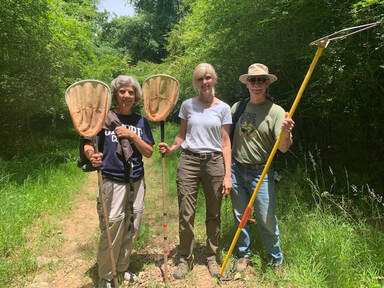|
By Theodosia Wade, Past Sustainable Newton Board Member  Who Doesn’t Love a Creek? Thanks to the City of Oxford’s Sustainability Committee, I had a chance to play in the creek again with the Stream Team of GA and folks from UGA’s Warnell School of Forestry and Natural Resources. Since retiring, I really miss that part of teaching of Environmental Science at Oxford College, so it was a real treat for me to get my feet wet and my hands slimy. On Saturday, we sampled a stretch of Dried Indian Creek behind the Oxford College Organic Farm to see how many different kinds of fish we could find. Using an electro-shocker, the team collected fish from horny head chub to yellow fin shiners -- even a few salamanders. No worries though, it was all catch and release with 0% fish mortality. What a beautiful array of fish, many in their brilliant breeding colors. Our concern is the health of Dried Indian Creek, which begins north of the Covington Airport and winds through Oxford, as it continues through Covington and on downstream into the Yellow River. One of the ways to assess stream health is by looking at the fish population for numbers of individuals, numbers of species, and species tolerance levels to stressors like sediment, chemicals, warm water, etc. Looking at land use patterns in the watershed surrounding Dried Indian Creek and changes in the stream buffer over the years helps us understand how urban growth has impacted the creek and aquatic organisms. The fish populations in Dried Indian Creek have declined over the years. Streams are valuable resources for people and wildlife alike. They fill reservoirs where we get our drinking water, serve as wildlife corridors for many land animals, and provide habitat for our aquatic organisms. Streams also protect us from floods. One of the things we looked at was the streambank of Dried Indian Creek. In places it was the nice, vegetated sloping bank of a healthy stream. But in most places, the streambank was eroded with little to no vegetation. As we pave over more of the watershed, less water permeates the ground and instead rushes into the stream during heavy downpours. This fast-moving water scours the stream bank and destroys habitat for fish and insects. Vegetated stream buffers and watersheds also help absorb carbon dioxide which helps reduce the effects of climate change in addition to improving the air we all breathe. Healthy streams are essential for healthy humans! I am thrilled that the City of Oxford is taking interest in this creek, seeing the value in a healthy stream. The City of Covington is likewise focused on preserving and restoring Dried Indian Creek as it flows through what will become the city’s Central Park. It’s encouraging to see local governments recognizing the connecting role of waterways that run between communities. People have been drawn to water since the beginning of time, and for those of us in the Piedmont eco-region of GA, streams are like oceans in our own backyards. They are a place to play as kids, to cool our feet in the heat of the summer, to stroll along their shaded banks on a hot afternoon, and to listen to the frogs and hear the birds singing their songs. Streams are good for our souls! Who doesn’t love a creek? Surely, we want to do what we can to keep these natural wonders healthy for generations to come. We encourage residents of Oxford, Covington, and surrounding communities to learn more about Dried Indian Creek and to contact your local officials to learn how you can support their efforts to clean up, protect, and preserve these vital wildlife habitats and valuable greenspaces. For an extended history of research into the Dried Indian Creek watershed, see this paper from researchers Steve C. Baker and Homer F. Sharp Jr.
1 Comment
|
Categories
All
Archives
February 2024
|
Photos from Chemist 4 U, shixart1985 (CC BY 2.0), Juhele_CZ, EarthLED, shixart1985, EcuaVoz, Chemist 4 U

 RSS Feed
RSS Feed
